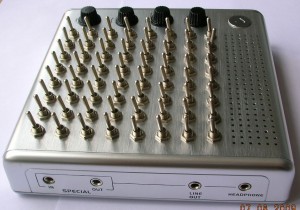Ed.: Resident hardware hacker and sound artist Michael Una chatted via phone with the creator of ThinkGeek’s $50 Bliptronic instrument. We’ve already got some early tips on how you might hack this design into custom creations, which could make the Bliptronic 5000 an ideal hardware hacker choice. (And, because it is cheap, you may be a little more adventurous with the thing.) Designer Ty Liotta also talks about prototyping, the design process, and reveals an entirely toggle-switch prototype that I wish they had actually shipped. It’s a must-read for hardware geeks. -PK
I just spoke to Ty Liotta, the head of ThinkGeek’s custom product group. They’re responsible for the playable guitar/drum kit t-shirts, and a number of other fun geeky things.
The development team started working on a grid-button synth back in April, inspired by the Monome and the Tenori-on. Their goal was to make it as low-cost as possible while retaining a sense of fun and playability. Cost was a big factor in their design process; the Thinkgeek team is well aware of the exisiting devices in the marketplace and didn’t want to directly compete with the APC or the Launchpad’s price points.
The first prototype was inspired by the grid layout but had a set of 64 switches instead of membrane buttons and LEDs:

The switches were intended to be a cost-saving measure, but the engineers figured out that it was actually a little bit cheaper to use LEDs and the plastic buttons. The sounds come from a standard Casio-type FM synth chip, which is controlled by the onboard sequencer/logic chip. The Bliptronic can be chained together with other units to form longer sequences via the sync jack on the side, which operates via voltage pulses.
The team made sure that the operating BPMs (60 to 180 in 20BPM increments) are accurate, so you can play it side-by-side with another device until they drift apart (check out the end of the demo video with the Kaoss Pad).
The intended audience here is music/synth geeks firstly, but Ty hopes the device’s low cost and intuitive playability will appeal to kids and a more mainstream audience as well. If the Bliptronic does well, the team hopes to offer a slightly higher-priced version with MIDI (exactly how they’ll implement MIDI control is still being discussed). Ty’s first idea is that the Bliptronic could send MIDI notes as a visual step sequencer, but he talked about the possibility of external clock synching as well.
We also discussed possible hacks and modifications to the Bliptronic, and Ty offered a few suggestions and hints. Firstly, he suggested that anyone looking to build a Monome-type controller with visual feedback would find that the button-and-LED matrix can be easily repurposed. Since this is usually the most expensive/time-consuming step, people might find this a cost-effective part.
Another angle of attack may be to get at the tempo adjustment and sync controls, if you’re looking to hack in your own external MIDI clocking- I myself plan to pursue this angle as soon as the unit I ordered arrives.
Also, Ty mentioned that the synth chip is external to the logic controller, so I assume that one could circuit-bend that chip independently of the logic controls. There may also be some unimplemented sounds waiting on the chip, and it may be possible to modify the scales played. I’m fairly familiar with some of these chips used in the casio-clone keyboards found at thrift stores- makes me wonder if there are some drum sounds hiding in there as well.
I’ll keep everyone here updated on my modifications and discoveries once I get my hands on one of these little guys, but early indications are that the Bliptronic 5000 might be on par with the Gakken SX-150 in terms of both price and bendability.